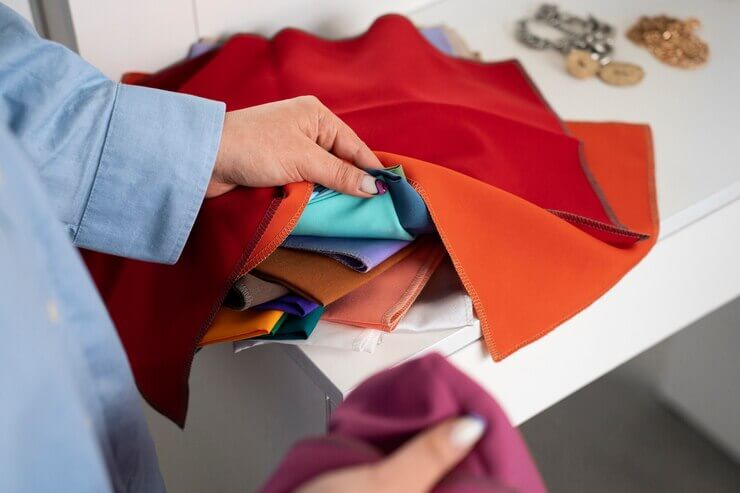The term “Tulliste” directly refers to Tulle, which can mean both the fine netting fabric and the city in France known for its production. It is known in English as Tulle, which can mean both the fine netting Fabric and the place. It represents more than just a fabric. Its history is rooted in the quaint town of Tulle, France.
This delicate meshwork fabric has become a cornerstone of both avant-garde fashion and timeless elegance.
A Fusion of Tradition and Innovation stands as:
- Testament to this harmonious fusion
- Creating looks that range from ethereal to edgy
- Avant-garde fashion pieces that seek to make a statement
- Proving that this fabric can transcend any style boundary
- The versatility allows designers to experiment
The fashion industry reveres it for its:
- Ability to add volume
- Delicacy
- Quality of garments
It’s the go-to fabric for:
- Wedding dresses
- Veils and Ballet Tutus
How did Tulliste, with origins in a small French town, come to redefine the boundaries of fashion and interior design?
In this blog, we intend to have an overview of Tulliste, it includes:
- A Brief History of Tulliste: Tracing the roots of this exquisite fabric
- The Art of Tulliste Production: Understanding the meticulous process behind its creation
- Tulliste Types and Uses: Examining the fabric’s versatility across fashion and decor
- Tulliste in Modern Aesthetics: How Tulliste blends tradition with contemporary design in both fashion and interior settings
- Frequently Asked Questions: Answering the most common curiosities about Tulliste
- Conclusion: Reflecting on the enduring elegance and significance of Tulliste
A Brief History
Tulliste’s journey begins in Tulle, a city with a rich history in textile production. Traditionally, Tuliste used to be from silk, cotton, or nylon. It has evolved over the centuries. Always maintained its status as a symbol of luxury and style. The unique pattern of the fabric is a remarkable example of the skilled artistry of its makers. It also shows the timeless appeal of this brand to anything it is used on.
The Art of Tulliste Production: From Raw Materials to Luxurious Textiles

The initiation from raw material to the finest fabric, Tulliste textile is steeped in traditional techniques with contemporary innovation and skills:
- It begins with the selection of the finest fibers.
- Followed by meticulous processes such as scouring, carding, and spinning.
- Weaving then transforms these fibers into the iconic mesh fabric.
- Finally, the finishing touch accentuates its beauty and functionality.
The Craftsmanship Behind Tulliste
The meticulous process of creating Tulliste fabric is a testament to the dedication and skill of its people. Their commitment to quality ensures that its fabric not only looks beautiful but also stands the test of time.
Types and Uses- From Garments to Interior Decor

Tulliste each type serves a unique purpose. It has a wide range of types and applications for both garments and home decor:
- Silk can be used in clothing like evening gowns, blouses, scarves, ties, home decor etc.
- Cotton is perfect for casual wear, and summer garments. Also, works well in home décor, such as curtain or bedding sets.
- Velvet with soft pile and rich colors can be used in evening wear. Also, can be used in upholstery projects for chairs or sofas
- Linen garments are perfect for warm weather. It is also used in tablecloths and napkins
It offers the essence of timeless elegance and versatility across various applications. Whether choose silk for an upscale event or linen for everyday use, these fabrics elevate luxury and style.
Tulliste in Modern Design: Merging Tradition with Modern Aesthetics
Its timeless elegance is seamlessly integrated into contemporary design, bridging the gap between past and present. In fashion,
- It adds a layer of sophistication to classic and modern design.
- It brings texture and depth, enriching spaces with a subtle touch of luxury interior design.
Choosing Tulliste means availing a piece of history and artistry. It bridges the gap between past and present with its quality and designs of tradition & innovation.
FAQs on Tulliste (Tulle)

- What is Tulliste?
It refers to a specific type of fine, lightweight, netted fabric known in English as Tulle. It is based the Tulle city in France. This fabric is renowned for its delicate appearance and versatility in fashion and decor.
- When was Tulle fabric first used?
Tulle fabric has been utilized for centuries. It became popular in the 18th century. Its exact origins are quite hard to highlight but it has been famous in European fashion since the 1700s.
- Why is the fabric called Tulliste or Tulle?
The fabric is called Tulle after the city of Tulle in France. It is known for its production in fine netting.
- How is Tulle fabric used?
Tulle is incredibly versatile and used in various applications, as we talked about above under the heading of “Types and Uses- From Garments to Interior Décor”.
- Can Tulle be produced outside of Tulle, France?
Yes, Tulle is produced in various locations around the world.
- Is Tulle difficult to care for?
Tulle can be delicate, especially when made from natural fibers like silk. It is recommended to follow specific care instructions.
- How has Tulle fabric evolved?
While Tulle has retained its basic mesh structure over time, its applications and the fibers used to produce it have evolved. Modern technological advancements have introduced more durable and varied types of Tulle. Expanding its use beyond traditional garments to include a wider range of fashion and decorative items.
Conclusion
Wrapping up, Tulliste (Tulle) is not just fabric; it’s a lasting symbol of beauty that brings style to clothes and homes alike. It shows that true elegance is timeless and knows no limits. From its roots in Tulle, France, to today’s fashion, Tulliste adds attraction and inspiration.







